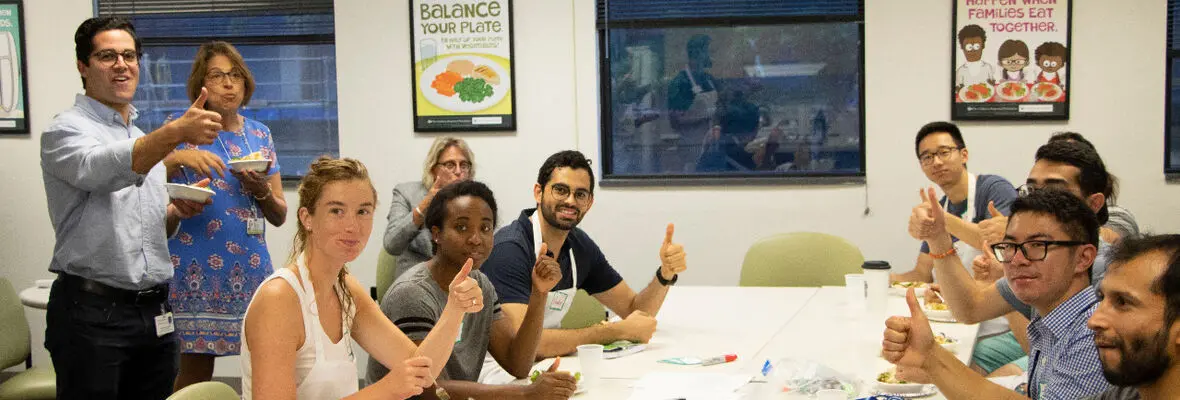About
Culinary medicine is the combination of the science of medicine and the culinary arts. Culinary medicine has gained significant interest in medical schools as a way to teach nutrition, improve student confidence in counseling patients with diet-associated diseases, and foster student community and wellness [1]. A recent study demonstrated that medical students with hands-on nutrition education improve their competencies counseling patients on nutrition, while improving students' own diets [2]. The teaching kitchen is the ideal environment for such learning because it enables students to see their study of evidenced based-nutrition come to life. Students acquire nutrition knowledge and confidence in food preparation, a recipe for success in counseling patients with diet-associated diseases.
One of the core principles described by the earliest western physicians, including Hippocrates, was the effect of lifestyle on health. At that time the treatment of many ailments centered on diet and exercise. Since then advancements in medicine have enabled physicians to prescribe medications and perform surgical procedures, improving outcomes for a wide range of diseases. However, these beneficial developments have had the unfortunate consequence of downplaying the influence of diet and lifestyle on health. As a result, diet-associated chronic diseases have been on the rise since the mid-20th century and are now the leading causes of morbidity and mortality in the United States [3-6].
The National Research Council’s 1985 report Nutrition Education in U.S. Medical Schools acknowledged the lack of nutrition instruction in medical schools, and recommended 25-30 hours of nutrition education in undergraduate medical education [7]. Adams et. al has surveyed all U.S. medical schools every four years since 2000 and consistently found that most do not come close to meeting the recommendation [8-10]. Data from 2015 show that of the 121 out of 133 medical schools that responded, 71% failed to meet the minimum 25 hour recommendation, and 36% provided less than half that much [10]. These results are alarmingly, especially given the importance of diet’s role in obesity, diabetes, heart disease, and many other conditions, and data demonstrating that counseling on high-quality, whole foods can improve patient outcomes [11].
Penn Culinary Medicine started in August 2018 as an 8-session, 4-week elective for 4th year medical students to learn core nutrition concepts and dietary counseling techniques, preparing them to promote healthy eating in their future patients. The course--taught by a team of culinary experts, physicians, and registered dietitians--utilized primary literature readings, didactics, case-based discussions, and recipe preparation to teach students about a range of diet-associated diseases; dietary approaches for prevention and treatment of disease; culinary skills; and food accessibility, cost, and taste. In addition, students learned about the many contributors to food choices including health, culture, religion, stress, cost, taste, and various others. Through a partnership with the Netter Center, medical students taking the culinary medicine elective taught local high school students on a range of nutrition concepts.
Starting in the Spring of 2020 Penn Culinary Medicine will be expanding to include a Foundations course for 1st and 2nd year medical students and a Community course where 4th year medical students will be teaching nutrition and culinary skills to local community members. More information coming soon!
The mission of Penn Culinary Medicine is to combine the art of food and cooking with the science of medicine in order to promote evidence-based nutritional education for medical students and patients and empower the community with healthy eating habits.
1. La puma J. What Is Culinary Medicine and What Does It Do?. Popul Health Manag. 2016;19(1):1-3.
2. Monlezun DJ, Dart L, Vanbeber A, et al. Machine Learning-Augmented Propensity Score-Adjusted Multilevel Mixed Effects Panel Analysis of Hands-On Cooking and Nutrition Education versus Traditional Curriculum for Medical Students as Preventive Cardiology: Multisite Cohort Study of 3,248 Trainees over 5 Years. BioMed Research International. 2018; Article ID 5051289: 1-10.
3. Afshin A, Forouzanfar MH, Reitsma MB, et al. Health Effects of Overweight and Obesity in 195 Countries over 25 Years. N Engl J Med. 2017;377(1):13-27.
4. Bogers RP, Bemelmans WJ, Hoogenveen RT, et al. Association of overweight with increased risk of coronary heart disease partly independent of blood pressure and cholesterol levels: a meta-analysis of 21 cohort studies including more than 300 000 persons. Arch Intern Med. 2007;167(16):1720-8.
5. Borrell LN, Samuel L. Body mass index categories and mortality risk in US adults: the effect of overweight and obesity on advancing death. Am J Public Health. 2014;104(3):512-9.
6. Bhaskaran K, Douglas I, Forbes H, Dos-santos-silva I, Leon DA, Smeeth L. Body-mass index and risk of 22 specific cancers: a population-based cohort study of 5·24 million UK adults. Lancet. 2014;384(9945):755-65.
7. Committee on Nutrition in Medical Education FaNB, Commission on Life Sciences, and National Research Council, Nutrition Education in U.S. Medical Schools, The National Academies Press, Washington, DC, USA, 1985.
8. Adams KM, Lindell KC, Kohlmeier M, and Zeisel SH. Status of nutrition education in medical schools. Am J Clin Nutr. 2006;83(4):941S-944S.
9. Adams KM, Kohlmeier M, and Zeisel SH. Nutrition education in U.S. medical schools: latest update of a national survey. Acad Med. 2010;85(9):1537-1542.
10. Adams KM, Butsch WS, and Kohlmeier M. The State of Nutrition Education at US Medical Schools. J Biomed Ed. 2015; Article ID 357627, 1-7.
11. Grossman DC, Bibbins-domingo K, Curry SJ, et al. Behavioral Counseling to Promote a Healthful Diet and Physical Activity for Cardiovascular Disease Prevention in Adults Without Cardiovascular Risk Factors: US Preventive Services Task Force Recommendation Statement. JAMA. 2017;318(2):167-174.


